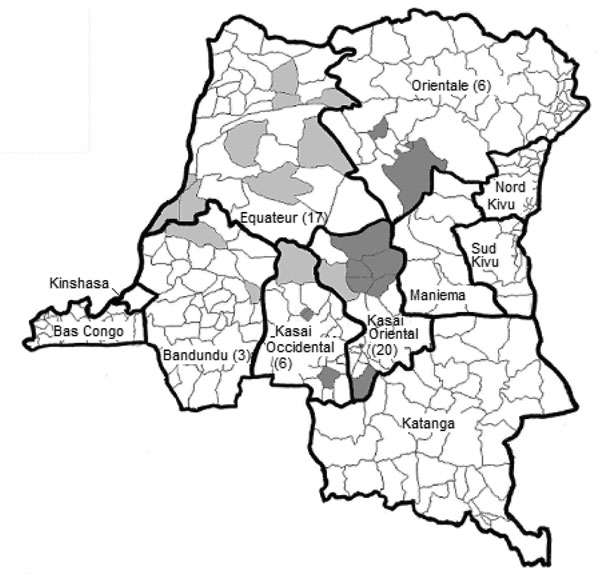Endemic Human Monkeypox, Democratic Republic of Congo, 2001–2004
Anne W. Rimoin*, Neville Kisalu†, Benoit Kebela-Ilunga‡, Thibaut Mukaba†, Linda L. Wright§, Pierre Formenty¶, Nathan D. Wolfe#, Robert Loshima Shongo‡, Florimond Tshioko**, Emile Okitolonda††, Jean-Jacques Muyembe†, Robert W. Ryder‡‡, and Hermann Meyer§§

Author affiliations: *University of California, Los Angeles, California, USA; †National Institute of Biomedical Research, Kinshasa, Democratic Republic of Congo; ‡Ministry of Health, Kinshasa, Democratic Republic of Congo; §National Institutes of Health, Bethesda, Maryland, USA; ¶World Health Organization, Geneva, Switzerland; #Johns Hopkins Bloomberg School of Public Health, Baltimore, Maryland, USA; **World Health Organization, Kinshasa, Democratic Republic of Congo; ††Kinshasa School of Public Health, Kinshasa, Democratic Republic of Congo; ‡‡University of North Carolina, Chapel Hill, North Carolina, USA; §§Bundeswehr Institute of Microbiology, Munich, Germany;
Main Article
Figure 1

Figure 1. Distribution of 52 confirmed cases of human monkeypox (MPX) by health zone in the Democratic Republic of Congo (DRC), 2001–2004. The cumulative number of cases per province is in parentheses. Confirmed cases of MPX originated from a total of 26 different health zones located in 5 provinces of DRC; most (70.5%) were reported from Kasai Oriental and Equateur Provinces. Two groups can be differentiated on the basis of sequence of the hemagglutinin gene: light gray, group 1; dark gray, group 2. Note: The boundaries of the DRC health zones have since been redrawn. Although the health zones Tshopo and Mweka are not shown (located in provinces Orientale and Kasai Occidental, respectively), the general area is highlighted to represent MPX cases in these regions.
Main Article
Page created: July 01, 2010
Page updated: July 01, 2010
Page reviewed: July 01, 2010
The conclusions, findings, and opinions expressed by authors contributing to this journal do not necessarily reflect the official position of the U.S. Department of Health and Human Services, the Public Health Service, the Centers for Disease Control and Prevention, or the authors' affiliated institutions. Use of trade names is for identification only and does not imply endorsement by any of the groups named above.
